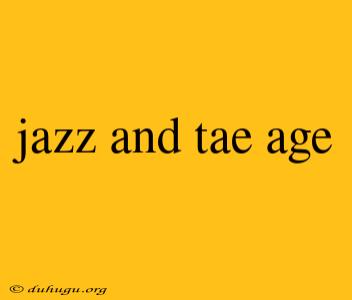Jazz and Tae Age: A Harmonious Blend of Music and Martial Arts
In the realm of music and martial arts, two seemingly disparate worlds converge to form a unique and fascinating fusion. Jazz and Tae Age, a concept that may seem unconventional at first, reveals a profound connection between the improvisational spirit of jazz music and the disciplined movements of Tae Age, a Korean martial art. In this article, we'll delve into the intriguing relationship between jazz and Tae Age, exploring the parallels and intersections that make this unlikely pairing a harmonious blend.
The Improvisational Nature of Jazz
Jazz, an American music genre born in the early 20th century, is characterized by its spontaneous and improvisational nature. Jazz musicians, often masters of their instruments, create complex melodies and harmonies on the fly, responding to the moment and the energy of their surroundings. This freedom to explore and express, unshackled by rigid structures, is at the heart of jazz's allure.
The Disciplined Movement of Tae Age
Tae Age, a Korean martial art, emphasizes discipline, focus, and control. Practitioners, often trained from a young age, master intricate patterns of movement, combining kicking, punching, and blocking techniques with meditation and breathing exercises. The precision and coordination required to execute these movements demand a high level of physical and mental discipline.
Parallels Between Jazz and Tae Age
At first glance, the relationship between jazz and Tae Age may seem tenuous. However, upon closer examination, several parallels emerge:
Improvisation and Adaptation
In jazz, musicians must adapt to the moment, responding to the unexpected and creating new sounds on the fly. Similarly, Tae Age practitioners must adapt to changing circumstances, counterattacks, and their own physical limitations. Both jazz and Tae Age require an openness to new possibilities and a willingness to evolve.
Spontaneity and Structure
While jazz is often associated with improvisation, it also relies on a deep understanding of musical structures, such as chord progressions and scales. Tae Age, too, combines structured patterns with spontaneous expression, as practitioners must respond to their opponent's movements and react in the heat of the moment.
Rhythm and Timing
In jazz, rhythm and timing are crucial elements, as musicians must synchronize their playing to create a cohesive sound. In Tae Age, practitioners must master timing and coordination to execute complex movements and counterattacks. The importance of rhythm and timing creates a common thread between these two seemingly disparate disciplines.
The Harmonious Blend
As we explore the connections between jazz and Tae Age, it becomes clear that these two art forms share a common essence. Both jazz and Tae Age value creativity, discipline, and spontaneity, combining freedom with structure to produce a unique and beautiful expression.
In the marriage of jazz and Tae Age, we find a harmonious blend of music and martial arts, where the improvisational spirit of jazz meets the disciplined movement of Tae Age. This unlikely pairing reveals the versatility and creativity of human expression, reminding us that the boundaries between art forms are meant to be pushed and blurred.
Conclusion
The harmonious blend of jazz and Tae Age serves as a reminder that creativity and discipline are not mutually exclusive, but rather complementary elements that can come together to create something truly remarkable. As we explore the intersections of music and martial arts, we may just discover a new language, one that speaks to the very heart of human expression.
